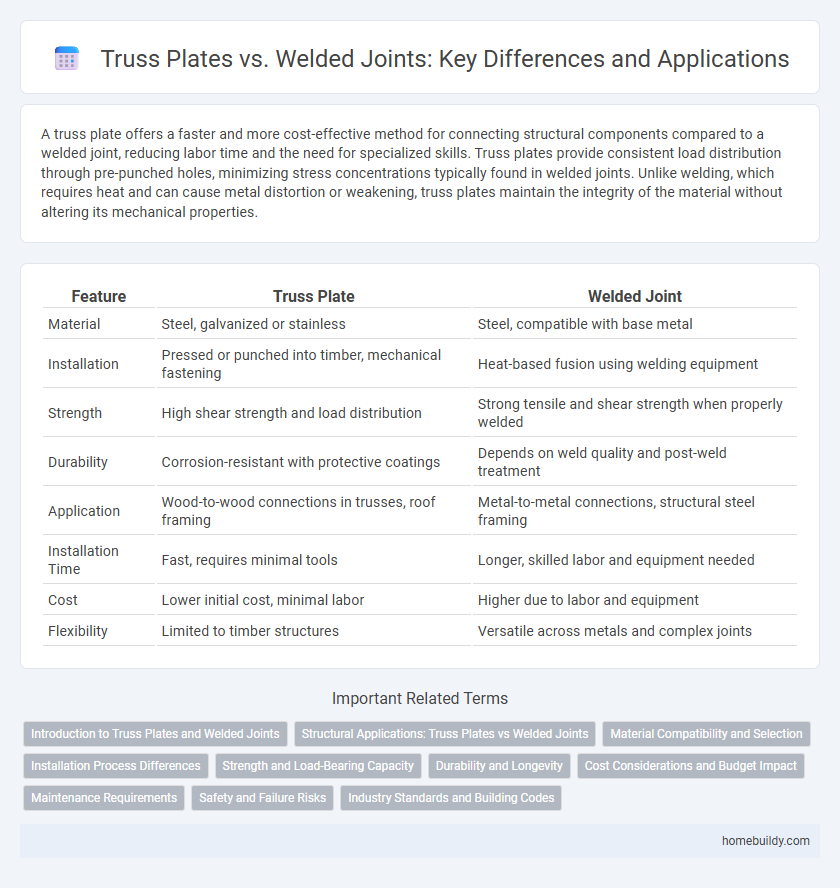A truss plate offers a faster and more cost-effective method for connecting structural components compared to a welded joint, reducing labor time and the need for specialized skills. Truss plates provide consistent load distribution through pre-punched holes, minimizing stress concentrations typically found in welded joints. Unlike welding, which requires heat and can cause metal distortion or weakening, truss plates maintain the integrity of the material without altering its mechanical properties.
Table of Comparison
| Feature | Truss Plate | Welded Joint |
|---|---|---|
| Material | Steel, galvanized or stainless | Steel, compatible with base metal |
| Installation | Pressed or punched into timber, mechanical fastening | Heat-based fusion using welding equipment |
| Strength | High shear strength and load distribution | Strong tensile and shear strength when properly welded |
| Durability | Corrosion-resistant with protective coatings | Depends on weld quality and post-weld treatment |
| Application | Wood-to-wood connections in trusses, roof framing | Metal-to-metal connections, structural steel framing |
| Installation Time | Fast, requires minimal tools | Longer, skilled labor and equipment needed |
| Cost | Lower initial cost, minimal labor | Higher due to labor and equipment |
| Flexibility | Limited to timber structures | Versatile across metals and complex joints |
Introduction to Truss Plates and Welded Joints
Truss plates are specialized steel connectors with multiple teeth that penetrate wooden members to form strong, stable joints in timber frameworks. Welded joints involve fusing metal components through localized heating, creating a seamless bond primarily used in steel construction. Both methods offer distinct advantages in structural integrity, with truss plates optimized for wood assemblies and welded joints preferred for metal frameworks.
Structural Applications: Truss Plates vs Welded Joints
Truss plates offer a reliable and efficient method for connecting timber elements in structural frameworks, providing uniform load distribution and ease of installation compared to welded joints. Welded joints, typically used in steel structures, deliver exceptional strength but can introduce residual stresses and require skilled labor for precise execution. In structural applications, truss plates are preferred for timber assemblies due to their cost-effectiveness and speed, while welded joints remain essential for steel frameworks demanding high rigidity and durability.
Material Compatibility and Selection
Truss plates are typically fabricated from galvanized steel, offering excellent corrosion resistance and compatibility with various timber species, ensuring durable joint performance. Welded joints rely on compatible metals such as mild or stainless steel, requiring precise material selection to prevent galvanic corrosion and maintain structural integrity. Material selection in truss plates prioritizes ease of installation and long-term durability, while welded joints demand careful alloy matching and controlled welding processes for optimal compatibility.
Installation Process Differences
Truss plates are typically installed using a mechanical pressing process that secures the plate onto timber joints quickly and with minimal skilled labor, whereas welded joints require specialized welding equipment and certified welders for precise fusion. The truss plate installation is faster and less labor-intensive, making it ideal for mass production in timber framing. Welded joints demand more preparation and safety measures, increasing installation time and complexity in structural steel applications.
Strength and Load-Bearing Capacity
Truss plates provide superior load distribution across multiple points, enhancing overall structural strength compared to welded joints that concentrate stress at the weld area. The perforated design of truss plates allows for better wood penetration and reduced risk of metal fatigue, resulting in higher load-bearing capacity in timber construction. Welded joints, while strong for metal frameworks, often fail to match the durability and flexibility of truss plates in resisting dynamic loads and shear forces in truss assemblies.
Durability and Longevity
Truss plates offer superior durability compared to welded joints due to their corrosion-resistant galvanized steel construction, which maintains structural integrity over time without the risk of weld fatigue or cracking. The longevity of truss plates is enhanced by their ability to evenly distribute loads and resist environmental stressors, ensuring consistent performance in wood truss connections. In contrast, welded joints may deteriorate faster due to heat-affected zones and potential weld defects, reducing the lifespan of the structural assembly.
Cost Considerations and Budget Impact
Truss plates generally offer a more cost-effective solution compared to welded joints due to lower labor and equipment expenses. The installation of truss plates requires less specialized skill and faster assembly time, reducing overall project labor costs and minimizing budget overruns. Welded joints, while providing strong and rigid connections, typically involve higher upfront costs, including skilled labor and quality control measures, which can significantly impact tighter budgets.
Maintenance Requirements
Truss plates require minimal maintenance compared to welded joints, as they rely on mechanical fastening that avoids heat-affected zones prone to cracking. Welded joints often need regular inspection for corrosion, cracks, and fatigue due to the thermal stresses introduced during welding. The simplicity of truss plate connections reduces the need for specialized maintenance, making them a cost-effective solution for long-term structural integrity.
Safety and Failure Risks
Truss plates provide a safer connection method compared to welded joints by distributing loads evenly through multiple fasteners, reducing stress concentrations that often cause weld failures. Welded joints are prone to defects like cracks and incomplete fusion, increasing the risk of structural failure under dynamic loads or fatigue. Using truss plates minimizes failure risks by enhancing joint redundancy and allowing for easier inspection and maintenance.
Industry Standards and Building Codes
Truss plates must comply with industry standards such as ANSI/TPI 1 and ICC-ES AC13, ensuring certified performance for load transfer and structural integrity, while welded joints are governed by codes like AWS D1.1 that specify weld quality and inspection criteria. Building codes including the International Building Code (IBC) recognize truss plates for their standardized, factory-controlled manufacture, offering consistent strength and reliability, whereas welded joints often require on-site inspection and can vary with workmanship. The enforced requirements in these standards directly impact design approval, safety factors, and durability in wood and steel construction applications.
Truss plate vs Welded joint Infographic

 homebuildy.com
homebuildy.com